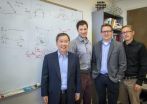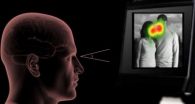(Press-News.org) One of the major road blocks to the design and development of new, more efficient solar cells may have been cleared. Researchers with the Lawrence Berkeley National Laboratory (Berkeley Lab) have developed the first ab initio method – meaning a theoretical model free of adjustable or empirical parameters – for characterizing the properties of "hot carriers" in semiconductors. Hot carriers are electrical charge carriers - electrons and holes – with significantly higher energy than charge carriers at thermal equilibrium.
"Hot carrier thermalization is a major source of efficiency loss in solar cells, but because of the sub-picosecond time scale and complex physics involved, characterization of hot carriers has long been a challenge even for the simplest materials," says Steven Louie, a theoretical physicist and senior faculty scientist with Berkeley Lab's Materials Sciences Division (MSD). "Our work is the first ab initio calculation of the key quantities of interest for hot carriers - lifetime, which tells us how long it takes for hot carriers to lose energy, and the mean free path, which tells us how far the hot carriers can travel before losing their energy."
All previous theoretical methods for computing these values required empirical parameters extracted from transport or optical measurements of high quality samples, a requirement that among the notable semiconductor materials has only been achieved for silicon and gallium arsenide. The ab initio method developed by Louie and Jeff Neaton, Director of the Molecular Foundry, a U.S. Department of Energy (DOE) Nanoscience User Facility hosted at Berkeley Lab, working with Marco Bernardi, Derek Vigil-Fowler and Johannes Lischner, requires no experimental parameters other than the structure of the material.
"This means that we can study hot carriers in a variety of surfaces, nanostructures, and materials, such as inorganic and organic crystals, without relying on existing experiments," says Neaton. "We can even study materials that have not yet been synthesized. Since we can access structures that are ideal and defect-free with our methods, we can predict intrinsic lifetimes and mean free paths that are hard to extract from experiments due to the presence of impurities and defects in real samples. We can also use our model to directly evaluate the influence of defects and impurities."
Neaton, like Louie, is a senior MSD faculty scientist with the University of California (UC) Berkeley. Neaton also holds an appointment with the Kavli Institute for Energy Nanosciences. They are the corresponding authors of a paper in Physical Review Letters describing this work titled "Ab Initio Study of Hot Carriers in the First Picosecond after Sunlight Absorption in Silicon." Bernardi is the lead author of the paper, and Vigil-Fowler the primary coauthor.
Single-junction solar cells based on crystalline silicon are rapidly approaching the theoretical limit of their efficiency, which is approximately 30-percent. This means that if a silicon-based solar cell collects 1,000 Watts per square meter of energy, the most electricity it can generate is 300 Watts per square meter. Hot carriers are crucial to enhancing solar cell efficiency, since their thermalization results in the loss of as much as a third of the absorbed solar energy in silicon, and similar values in other semiconductors. However, the properties of hot carriers in complex materials for photovoltaic and other modern optoelectronic applications are still poorly understood.
"Our study was aimed at providing useful data for hot carrier dynamics in silicon with application in solar cells," says Bernardi. "In this study we provide calculations from first principles that describe the two key loss mechanisms, induced by electrons and phonons, respectively, with state-of-the-art accuracy and within the frameworks of density functional and many-body perturbation theories."
When the research team applied their method to study the relaxation time and mean free path of hot carriers in silicon, they found that thermalization under solar illumination is completed within 350 femtoseconds, and is dominated by phonon emission from hot carriers, a process that becomes progressively slower as the hot carriers lose energy and relax toward the band edges. This modeling result was in excellent agreement with the results of pump-probe experiments. While the model was only tested on silicon in this study, the researchers are confident it will be equally successful with other materials.
"We believe our approach is highly valuable to experimental groups studying hot carriers in the context of solar cells and other renewable energy technologies as it can be used to compute the lifetime and mean free path of hot carriers with specific energies, momenta, and crystallographic directions with unprecedented resolution," Bernardi says. "As we expand our study of hot carriers to a range of crystalline materials and nanostructures, we believe that our data will provide unique microscopic insight to guide new experiments on hot carriers in semiconductors."
INFORMATION:
This research was supported by the DOE Office of Science and the National Science Foundation and made use of the Molecular Foundry, as well as computational resources of the National Energy Research Scientific Computing Center (NERSC), which is also supported by the DOE Office of Science.
Lawrence Berkeley National Laboratory addresses the world's most urgent scientific challenges by advancing sustainable energy, protecting human health, creating new materials, and revealing the origin and fate of the universe. Founded in 1931, Berkeley Lab's scientific expertise has been recognized with 13 Nobel prizes. The University of California manages Berkeley Lab for the U.S. Department of Energy's Office of Science. For more, visit http://www.lbl.gov.
First ab initio method for characterizing hot carriers
Could hold the key to future solar cell efficiencies
2014-07-17
ELSE PRESS RELEASES FROM THIS DATE:
Untangling spider's webs
2014-07-17
For decades, the story of spider evolution went like this: As insects became more and more diverse, with some species taking to the skies, spiders evolved new hunting strategies, including the ability to weave orb-shaped webs to trap their prey.
From that single origin, the story goes, orb-weaver spiders diverged along different evolutionary paths, leading to today, where several species weave similar – though not identical – webs.
It's a good story, but there's just one problem – Harvard scientists now know it's not true.
The largest-ever phylogenetic study of ...
Eye movements reveal difference between love and lust
2014-07-17
Soul singer Betty Everett once proclaimed, "If you want to know if he loves you so, it's in his kiss." But a new study by University of Chicago researchers suggests the difference between love and lust might be in the eyes after all.
Specifically, where your date looks at you could indicate whether love or lust is in the cards. The new study found that eye patterns concentrate on a stranger's face if the viewer sees that person as a potential partner in romantic love, but the viewer gazes more at the other person's body if he or she is feeling sexual desire. That automatic ...
Atlantic salmon also show capacity to adapt to warmer waters
2014-07-17
Populations of Atlantic salmon have a surprisingly good capacity to adjust to warmer temperatures that are being seen with climate change, a group of scientists at the University of Oslo and University of British Columbia have discovered. The finding about Atlantic species adds to recent UBC-supported research on heat tolerance of Pacific salmon.
The new study, a collaboration between Norwegian and Canadian researchers, was recently published in Nature Communications. Funded by the Norwegian Research Council, it addressed questions around how climate change might affect ...
Eating lean beef daily can help lower blood pressure
2014-07-17
Contrary to conventional wisdom, a growing body of evidence shows that eating lean beef can reduce risk factors for heart disease, according to recent research by nutritional scientists.
"This research adds to the significant evidence, including work previously done in our lab, that supports lean beef's role in a heart-healthy diet," said Penny M. Kris-Etherton, Distinguished Professor of Nutrition, Penn State. "This study shows that nutrient-rich lean beef can be included as part of a heart-healthy diet that reduces blood pressure, which can help lower the risk for cardiovascular ...
Gut microbes turn carbs into colorectal cancer
2014-07-17
Colorectal cancer has been linked to carbohydrate-rich western diets, but the underlying mechanisms have been unclear. A study published by Cell Press July 17th in the journal Cell shows that gut microbes metabolize carbohydrates in the diet, causing intestinal cells to proliferate and form tumors in mice that are genetically predisposed to colorectal cancer. Treatment with antibiotics or a low-carbohydrate diet significantly reduced tumors in these mice, suggesting that these easy interventions could prevent a common type of colorectal cancer in humans.
"Because hereditary ...
Brown fat found to be at the root of cancer-related wasting syndrome
2014-07-17
VIDEO:
Many patients with advanced stages of cancer, AIDS, tuberculosis, and other diseases die from a condition called cachexia, which is characterized as a "wasting " syndrome that causes extreme thinness with...
Click here for more information.
Many patients with advanced stages of cancer, AIDS, tuberculosis, and other diseases die from a condition called cachexia, which is characterized as a "wasting" syndrome that causes extreme thinness with muscle weakness. ...
Obese women may have learning deficit specific to food
2014-07-17
Obese women have a deficit in reward-based learning, but only when food is involved. Importantly, say researchers who report their findings in the Cell Press journal Current Biology on July 17, those same women have no trouble at all forming accurate associations when the reward is money instead of food. The findings may lead to new, gender-appropriate ways to tackle the obesity epidemic.
"Our study shows that obesity may involve a specific impairment not in the processing of food itself, but rather in how obese individuals—or at least obese women—learn about cues in ...
Study identifies molecular key to healthy pregnancy
2014-07-17
Scientists have identified a crucial molecular key to healthy embryo implantation and pregnancy in a study that may offer new clues about the medical challenges of infertility/subfertility, abnormal placentation, and placenta previa.
Multi-institutional teams led by researchers at Cincinnati Children's Hospital Medical Center report their results in Cell Reports on July 17. The authors found that uterine expression of a gene called Wnt5a – a major signaling molecule in cell growth and movement in both embryo development and disease – is also critical to healthy embryo ...
First comprehensive library of master genetic switches in plants
2014-07-17
Researchers have created the first comprehensive library of genetic switches in plants, setting the stage for scientists around the globe to better understand how plants adapt to environmental changes and to design more robust plants for future food security.
The collection, which took more than 8 years and $5 million to create, contains about 2,000 clones of plant transcription factors, nature's genetic on/off switches. Manipulating these transcription factors enables scientists to improve plant traits such as cold resistance or seed quantity. The research will be published ...
Faithful cell division requires tightly controlled protein placement at the centromeres
2014-07-17
CAMBRIDGE, Mass. (July 17, 2014) – From fertilized egg to adult, the cells of the human body go through an astronomical number of divisions. During division of any of the body's roughly 30 trillion cells, DNA from the initial cell must be split precisely between the two resulting cells. Critical to successful cell division is the integrity of the centromere—a region of DNA on each chromosome where the cell division machinery attaches to segregate the chromosomes. For the segregation machinery to recognize this region, it must contain many copies of a pivotal protein known ...
LAST 30 PRESS RELEASES:
Injectable breast ‘implant’ offers alternative to traditional surgeries
Neuroscientists devise formulas to measure multilingualism
New prostate cancer trial seeks to reduce toxicity without sacrificing efficacy
Geometry shapes life
A CRISPR screen reveals many previously unrecognized genes required for brain development and a new neurodevelopmental disorder
Hot flush treatment has anti-breast cancer activity, study finds
Securing AI systems against growing cybersecurity threats
Longest observation of an active solar region
Why nail-biting, procrastination and other self-sabotaging behaviors are rooted in survival instincts
Regional variations in mechanical properties of porcine leptomeninges
Artificial empathy in therapy and healthcare: advancements in interpersonal interaction technologies
Why some brains switch gears more efficiently than others
UVA’s Jundong Li wins ICDM’S 2025 Tao Li Award for data mining, machine learning
UVA’s low-power, high-performance computer power player Mircea Stan earns National Academy of Inventors fellowship
Not playing by the rules: USU researcher explores filamentous algae dynamics in rivers
Do our body clocks influence our risk of dementia?
Anthropologists offer new evidence of bipedalism in long-debated fossil discovery
Safer receipt paper from wood
Dosage-sensitive genes suggest no whole-genome duplications in ancestral angiosperm
First ancient human herpesvirus genomes document their deep history with humans
Why Some Bacteria Survive Antibiotics and How to Stop Them - New study reveals that bacteria can survive antibiotic treatment through two fundamentally different “shutdown modes”
UCLA study links scar healing to dangerous placenta condition
CHANGE-seq-BE finds off-target changes in the genome from base editors
The Journal of Nuclear Medicine Ahead-of-Print Tip Sheet: January 2, 2026
Delayed or absent first dose of measles, mumps, and rubella vaccination
Trends in US preterm birth rates by household income and race and ethnicity
Study identifies potential biomarker linked to progression and brain inflammation in multiple sclerosis
Many mothers in Norway do not show up for postnatal check-ups
Researchers want to find out why quick clay is so unstable
Superradiant spins show teamwork at the quantum scale
[Press-News.org] First ab initio method for characterizing hot carriersCould hold the key to future solar cell efficiencies



